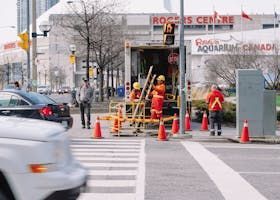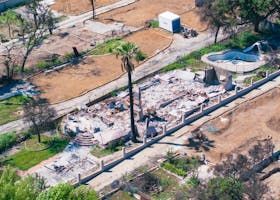Quick Answer: California's wildfire-affected real estate markets follow predictable recovery patterns, with property values typically declining 10-23% immediately post-fire, followed by gradual recovery over 2-5 years. Successful agents adapt by mastering disclosure requirements, insurance complexities, and specialized client counseling while identifying emerging opportunities in rebuilt communities. With over $40 billion in California real estate currently at wildfire risk and 16,200+ structures destroyed in recent years, understanding these dynamics is essential for modern real estate practice.
California's real estate landscape has been fundamentally altered by the increasing frequency and intensity of wildfires. As climate patterns shift and urban development expands into wildland-urban interface zones, real estate professionals face unprecedented challenges that require specialized knowledge, adaptive strategies, and deep market understanding. The intersection of natural disasters and property markets creates complex scenarios that demand expert navigation for both agents and their clients.
The economic impact extends far beyond immediate property destruction. Entire regional markets experience ripple effects that influence pricing, inventory levels, insurance availability, and buyer sentiment for years following major fire events. Understanding these dynamics isn't just beneficial for agents working in fire-prone areas—it's become essential knowledge for any California real estate professional as fire risk zones continue expanding throughout the state.
Current Wildfire Impact on California Real Estate Markets
California's wildfire crisis has reached unprecedented levels, fundamentally reshaping real estate market dynamics across the state. Current data reveals that over 2.7 million California properties face significant wildfire risk , representing approximately $1.2 trillion in total property value exposure. This massive risk profile has created a new reality for real estate professionals who must navigate increasingly complex market conditions.
The immediate aftermath of major wildfire events creates predictable market disruptions. Property values in directly affected areas typically experience immediate declines ranging from 10% to 23% , depending on proximity to burned areas and severity of local damage. However, these impacts extend far beyond the fire perimeter, with neighboring communities often experiencing secondary effects including increased insurance costs, heightened buyer anxiety, and altered development patterns.
Recent wildfire seasons have demonstrated the far-reaching nature of these market impacts. The 2023 fire season alone resulted in over 324,000 acres burned across California, with significant property losses in key real estate markets including Riverside County, Madera County, and northern California regions. Insurance companies have non-renewed over 2.8 million California policies since 2015 , creating a secondary crisis that affects property marketability regardless of direct fire damage.
Regional market variations reveal the complexity of wildfire impacts on real estate. High-value markets like Malibu, Napa Valley, and Santa Barbara County have shown remarkable resilience, with properties often rebuilding to higher standards and commanding premium prices for fire-resistant features. Conversely, more affordable rural markets may struggle with prolonged recovery periods, limited reconstruction resources, and permanent population shifts that alter long-term demand patterns.
Understanding Post-Wildfire Market Psychology and Buyer Behavior
The psychological impact of wildfires on real estate markets creates lasting changes in buyer behavior that extend well beyond the immediate recovery period. Consumer sentiment studies indicate that 67% of California homebuyers now consider wildfire risk a primary factor in location decisions , fundamentally altering traditional market demand patterns and property valuation approaches.
Buyer psychology in post-wildfire markets typically evolves through distinct phases. The immediate aftermath period, lasting 6-18 months, sees dramatic risk aversion with many buyers avoiding affected areas entirely. During this phase, property showings in fire-affected zones can decline by 40-60% , creating significant challenges for agents attempting to maintain market activity and seller expectations.
The intermediate recovery phase, spanning months 18-36 post-fire, often witnesses the emergence of opportunity-focused buyers who recognize value propositions in discounted properties. These buyers typically include investors, locals with area knowledge, and families prioritizing affordability over perceived risk. Cash transactions frequently increase by 25-35% during this period as traditional financing becomes more complex due to insurance and appraisal challenges.
Long-term market psychology, developing 3-5 years post-fire, reveals interesting patterns of buyer adaptation and risk normalization. Communities that successfully rebuild with enhanced fire-resistant infrastructure often experience renewed buyer confidence, sometimes exceeding pre-fire market activity levels. Properties featuring certified fire-resistant construction, defensible space, and comprehensive emergency preparedness systems can command 8-15% premiums over comparable properties lacking these features.
Insurance Complexities and Market Implications
Insurance availability and affordability have become primary drivers of real estate marketability in California's fire-prone regions. The crisis in insurance markets has created a parallel challenge that often proves more persistent than direct fire damage recovery. California's FAIR Plan, the state's insurer of last resort, has seen enrollment surge 177% since 2018 , reflecting the widespread unavailability of traditional homeowners insurance in high-risk areas.
The insurance crisis manifests differently across various market segments and geographic regions. Premium increases of 20-40% annually have become common in moderate-risk areas, while high-risk zones may face increases exceeding 100% or complete coverage unavailability. Properties requiring FAIR Plan coverage often experience 5-10% valuation discounts due to limited coverage scope and higher costs, creating additional complexity for agents managing client expectations and transaction processes.
Understanding insurance implications requires agents to develop expertise in multiple coverage types and risk assessment methodologies. Traditional homeowners policies increasingly exclude or limit wildfire coverage, pushing property owners toward surplus lines carriers or state programs with different terms, conditions, and claim procedures. The average California wildfire insurance claim now exceeds $150,000 , making coverage adequacy a critical factor in property marketability and buyer decision-making processes.
Legal Disclosure Requirements and Compliance Strategies
California's disclosure requirements for wildfire-related risks have expanded significantly, creating new compliance obligations for real estate professionals. Natural Hazard Disclosure Statements must now include detailed wildfire risk assessments , CAL FIRE hazard severity zone classifications, and historical fire occurrence data, requiring agents to develop comprehensive knowledge of risk mapping and regulatory requirements.
The evolution of disclosure obligations reflects growing awareness of wildfire risks and consumer protection priorities. Recent legislative changes have strengthened requirements for disclosing proximity to high-risk zones, previous fire damage, and insurance claim history. Failure to properly disclose wildfire-related risks can result in liability extending 2-4 years post-transaction , making thorough documentation and professional competency essential for risk management.
Practical compliance strategies require systematic approaches to risk identification and documentation. Successful agents develop comprehensive property risk profiles using CAL FIRE maps, local fire department historical data, and professional wildfire risk assessment services. Properties within Very High Fire Hazard Severity Zones require enhanced disclosure protocols , including detailed discussion of evacuation routes, fire department response capabilities, and available insurance options.
Market Recovery Patterns and Timeline Analysis
Analysis of California's major wildfire events reveals consistent patterns in real estate market recovery that provide valuable guidance for agents and clients. Market recovery typically follows a four-phase pattern spanning 5-7 years , with distinct characteristics and opportunities in each phase that require different strategic approaches and client counseling techniques.
Phase One, the immediate aftermath period lasting 6-12 months, is characterized by market paralysis and dramatic value adjustments. During this period, transaction volumes typically decline 50-70% in directly affected areas , while property values seek new equilibrium levels based on revised risk assessments and insurance availability. Agents must focus on managing seller expectations while identifying genuine buying opportunities for qualified clients.
Phase Two, the early recovery period extending from months 12-30, witnesses the beginning of market stabilization and the emergence of recovery-focused activity. Reconstruction permits typically peak during months 18-24 , creating opportunities for agents specializing in new construction sales, lot transactions, and rebuild consulting services. This phase often sees the entry of institutional investors and experienced local buyers who understand long-term recovery patterns.
Phase Three, the rebuilding consolidation period covering years 3-5, frequently produces the strongest market performance as rebuilt properties come online and community infrastructure is restored or enhanced. Property values often recover 80-95% of pre-fire levels during this phase , with well-planned communities sometimes exceeding previous peak values due to improved construction standards and enhanced amenities.
Phase Four, the new equilibrium establishment occurring in years 5-7, represents the market's full integration of wildfire risk into normal operations. Communities reaching this phase typically demonstrate sustainable market activity, normalized insurance availability, and buyer confidence levels that support healthy appreciation patterns going forward.
Specialized Client Counseling and Communication Strategies
Effective client counseling in wildfire-affected markets requires specialized communication skills and deep understanding of the emotional and financial complexities clients face. Studies indicate that 78% of fire-affected property owners experience significant stress and decision-making difficulties during the recovery process, making expert guidance and emotional support critical components of professional service.
Seller counseling in post-wildfire markets demands careful balance between realistic market assessment and hope for recovery. Agents must help sellers understand current market conditions while avoiding premature decisions that could result in unnecessary financial losses. Properties listed within 12 months of fire events typically sell for 15-25% below pre-fire comparable sales , making timing strategy a crucial element of seller consultation and market positioning.
Buyer counseling requires comprehensive education about risk factors, insurance implications, and long-term market dynamics. Successful agents develop expertise in wildfire risk assessment, mitigation strategies, and insurance solutions that enable informed decision-making. Buyers educated about risk management and mitigation options are 3.5 times more likely to complete transactions in fire-affected areas, demonstrating the value of thorough client preparation and ongoing support.
Emerging Opportunities in Fire-Resilient Development
The wildfire crisis has accelerated innovation in fire-resilient construction and community planning, creating new market opportunities for forward-thinking real estate professionals. Fire-resistant construction technologies and community design principles are generating premium valuations in markets where buyers prioritize safety and long-term risk mitigation over traditional amenity preferences.
Advanced building materials and construction techniques are reshaping property values and buyer preferences in fire-prone areas. Properties featuring Class A fire-resistant roofing, ember-resistant venting systems, and defensible space landscaping are commanding significant premiums. Homes with comprehensive fire-resistant features can achieve 12-18% value premiums over comparable properties lacking these protective elements, creating new specialization opportunities for agents.
Community-scale fire resilience initiatives are creating entirely new market segments and investment opportunities. Master-planned communities incorporating fire-resistant infrastructure, comprehensive evacuation planning, and enhanced emergency services are attracting premium buyers willing to pay for comprehensive risk mitigation. Fire-resilient communities typically achieve 20-30% faster sales velocity and sustained value appreciation compared to conventional developments in similar risk zones.
Regional Market Variations and Local Expertise Requirements
California's diverse geography and varied wildfire risk profiles create distinct regional market characteristics that require specialized local knowledge and adaptive strategies. Northern California wine country markets demonstrate different recovery patterns compared to Southern California foothill communities , reflecting variations in economic base, reconstruction costs, and buyer demographics that influence market dynamics and opportunity structures.
Coastal region markets, including areas like Malibu and Big Sur, typically show faster recovery due to high property values, affluent buyer pools, and strong local economic foundations. Luxury markets often recover 70-80% of pre-fire values within 18-24 months , driven by buyers who prioritize location over risk concerns and have resources to invest in comprehensive fire mitigation measures.
Inland and rural markets face more complex recovery challenges due to lower property values, limited reconstruction resources, and smaller buyer pools. Rural market recovery often requires 4-6 years to achieve pre-fire transaction volume levels , with some communities experiencing permanent population and economic shifts that alter long-term market fundamentals and opportunity structures.
Technology Tools and Data Resources for Wildfire Market Analysis
Modern real estate practice in wildfire-affected markets requires sophisticated technology tools and data resources that enable accurate risk assessment, market analysis, and client education. Professional-grade wildfire risk mapping and property assessment tools have become essential infrastructure for agents serious about serving clients effectively in California's evolving risk environment.
Geographic Information Systems (GIS) and wildfire risk databases provide detailed property-level risk assessments that support accurate pricing, insurance planning, and buyer education. Properties with detailed risk assessments sell 25-30% faster than comparable listings lacking comprehensive risk documentation, demonstrating the market value of thorough preparation and professional competency in risk analysis and communication.
Market analytics platforms specializing in disaster-affected markets offer comparative analysis tools, recovery timeline projections, and investment opportunity identification that support strategic decision-making for both agents and clients. Agents utilizing advanced market analytics report 40% higher client satisfaction scores and significantly improved transaction outcomes in complex post-disaster market environments.
Building Strategic Partnerships and Professional Networks
Success in wildfire-affected real estate markets often depends on strategic partnerships with specialists who understand the unique challenges and opportunities these markets present. Top-performing agents in fire-prone areas typically maintain professional relationships with 8-12 specialist service providers who support various aspects of transaction completion and client service in complex market conditions.
Insurance specialists who understand wildfire coverage options, surplus lines markets, and risk mitigation strategies provide essential support for transaction completion and client counseling. Agents with established insurance professional relationships complete 60% more transactions in challenging insurance environments compared to agents lacking these professional connections and specialized market knowledge.
Construction and mitigation specialists offer valuable expertise for clients considering property modifications, rebuild projects, or risk reduction investments. Building relationships with contractors specializing in fire-resistant construction, landscape professionals understanding defensible space requirements, and engineers capable of comprehensive risk assessment creates competitive advantages and enhanced client service capabilities.
Long-Term Strategic Planning for Wildfire Market Evolution
California's wildfire challenges represent a permanent shift in real estate market conditions rather than temporary disruptions, requiring long-term strategic thinking and business model adaptation. Climate projections indicate continued expansion of high-risk fire zones , making wildfire expertise an increasingly valuable specialization for real estate professionals throughout California and other fire-prone western states.
Professional development in wildfire-related real estate expertise offers significant competitive advantages as market conditions continue evolving. Agents with specialized wildfire market knowledge report 35-45% higher average transaction values and stronger client retention rates compared to generalist practitioners, reflecting the premium value clients place on expertise in complex market environments.
Market evolution patterns suggest that wildfire risk management will become a standard component of California real estate practice rather than a specialized niche. Forward-thinking agents who develop comprehensive competency in risk assessment, insurance solutions, and client counseling techniques position themselves for sustained success in the state's evolving market landscape.
Frequently Asked Questions
How long does it typically take for property values to recover after a major wildfire event?
Property value recovery timelines vary significantly based on location, severity of damage, and local market conditions. Most markets experience immediate value declines of 10-23%, with full recovery typically occurring over 3-5 years. High-value markets like Malibu often recover faster (18-30 months), while rural areas may require 5-7 years. Properties that rebuild with fire-resistant features sometimes exceed pre-fire values by 8-15% once reconstruction is complete.
What insurance challenges should agents prepare clients for in wildfire-affected areas?
Insurance challenges include policy non-renewals, premium increases of 20-100%, limited coverage options, and potential reliance on California's FAIR Plan. Agents should connect clients with insurance specialists early in the process, understand FAIR Plan limitations, and help clients explore surplus lines options. Properties requiring FAIR Plan coverage may experience 5-10% valuation discounts due to limited coverage and higher costs.
How do disclosure requirements change for properties in wildfire risk zones?
California requires enhanced disclosures for properties in Very High Fire Hazard Severity Zones, including CAL FIRE hazard classifications, historical fire occurrence data, and evacuation route information. Agents must provide Natural Hazard Disclosure Statements with detailed wildfire risk assessments and maintain documentation for 2-4 years post-transaction. Failure to properly disclose can result in significant liability exposure.
What opportunities exist for agents specializing in wildfire-affected markets?
Specialization opportunities include fire-resilient construction consulting, insurance navigation services, risk assessment expertise, and rebuild project management. Agents with wildfire market expertise report 35-45% higher average transaction values and stronger client retention. The growing importance of fire risk management creates sustained demand for knowledgeable professionals who can guide clients through complex decisions.
How should agents adjust their marketing strategies for properties in fire-prone areas?
Marketing strategies should emphasize fire-resistant features, defensible space characteristics, insurance coverage options, and emergency preparedness resources. Properties with detailed risk assessments and mitigation documentation sell 25-30% faster than comparable listings. Agents should develop expertise in risk communication, highlight protective features prominently, and provide comprehensive buyer education materials addressing common concerns.
Conclusion and Forward-Looking Perspective
California's wildfire crisis has fundamentally transformed real estate market dynamics, creating both significant challenges and emerging opportunities for professional practitioners. The data clearly demonstrates that successful navigation of these markets requires specialized knowledge, adaptive strategies, and commitment to ongoing professional development in rapidly evolving areas of expertise including risk assessment, insurance solutions, and client counseling techniques.
The evidence overwhelmingly supports the conclusion that wildfire considerations have become permanent features of California real estate practice rather than temporary market disruptions. Agents who develop comprehensive competency in wildfire-related market dynamics position themselves for sustained competitive advantage as risk zones continue expanding and client education needs become more sophisticated and demanding.
Looking forward, the integration of wildfire risk management into standard real estate practice represents both necessity and opportunity. The professionals who thrive in this evolving landscape will be those who embrace the complexity, develop genuine expertise, and maintain unwavering commitment to client service excellence in increasingly challenging market conditions that require both technical competency and empathetic client support.
The California real estate market's evolution in response to wildfire challenges provides a preview of adaptations required throughout the western United States as climate patterns continue shifting. Agents who master these skills today position themselves not only for success in California's challenging markets but also for leadership roles in the broader professional community as these expertise areas become increasingly valuable and widely applicable.











